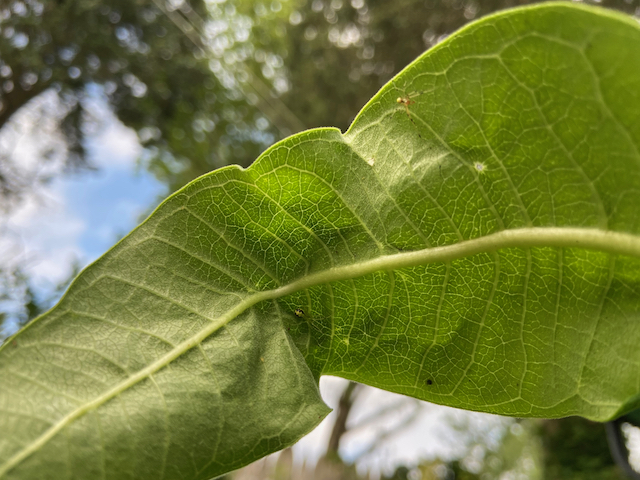Originally published October 7, 2015 in East Bay/South Coast life newspapers.
When I was first bitten by the gardening bug, I hated them. Insects and creepy crawlies of all stripes gave me the heebies. (Butterflies excepted.) Gardening for me was about being outside under a warm sun surrounded by the fragrances and prettiness of flowers, and the shapes and textures of foliage, full stop. Almost completely disconnected from the ecosystem. Although for the sake of my own health (and wallet) I never purchased an arsenal of toxic chemistry, I became a soapy water sharpshooter, doing my best to destroy the spittle bugs that bent the stems of my lavender, and left beer traps for slugs. I had it out for the aphids on rosebuds, and saw every hole in every leaf as a mortal wound and tragedy.
No more. Now I see those holes as little victories of nature over nurture.
My change of heart came slowly as I learned to appreciate certain insects, like bees, spiders, and praying mantids, for being “beneficial” helpers, and was followed, years later, by a great now-I-get-it epiphany that changed the way—and the why—I garden. The credit for that goes to Doug Tallamy, author of Bringing Nature Home, who argues for the use of native plant species. According to professor Tallamy, we need insects. Their job is to convert sunlight, by way of particular plants, into high protein food for those next up the food chain. In a nutshell, no insects, no birds. Everybody has to eat and our gardens should offer buffets.

Future swallowtail butterfly feasting on fennel.

Future swallowtail butterfly, in transition
I’m not alone in seeing the light through hole-y leaves. Back in September I attended a daylong program called “Your Backyard Matters”, offered by the Sogkonate Garden Club in Little Compton. During the morning session several members presented their experience and successes in gardening for particular wildlife. Some cultivate meadows that welcome nesting Bobolink. One couple propagates, sells, and donates dozens of species of trees, shrubs, and perennials that host native insects. Others have planted beds that attract pollinators and Monarch butterflies. And that afternoon, they each opened their gardens for inspection and inspiration.

The bee-friendly blues in a Little Compton pollinator garden

Taking the pollinator garden path in Little Compton
The take-home message was to recognize your own garden’s wildlife potential and run with it. I don’t have the requisite space for a meadow full of Bobolink hatchlings but my .17 acre plot is big enough to invite other types of songbirds, plenty of insects to feed them and their young, butterflies, and more species of pollinators than I can count on both hands.
It’s easy to garden for pollinators: plant more flowers. Butterflies need host plants for their caterpillars as well—Monarch caterpillars can only digest milkweed species plants. By planting native trees and shrubs for insects, along with seed and berry-bearing plants, such as coneflower and winterberry, I can help keep my favorite local songbirds fed year round. And by leaving the garden standing instead of putting everything “to bed” now, I can give them and the next generation of insects, including a lot of pollinators, a safe place to overwinter too.
I probably say this every fall, but unless your garden is infested with voles (who may only ever be discouraged by bare ground that makes them visible to predators—everybody has to eat) there’s no reason not to be a procrastinator now. You might argue that a fading garden looks messy; I’ll say quit worrying about what your neighbors might think. Besides, there’s tremendous beauty in senescence. The trick is to make fall’s “mess” look intentional and tidy. I remove broken and fallen stems. I trim unruly foliage (Siberian iris) and prune anything to the ground that might harbor a fungal disease (peonies). Most of the rest I enjoy through the winter and put off cutting back until spring when I’m desperate to be outside under a warm sun doing something vigorous.
Meanwhile though, until a hard frost signals winter, and barring any damage from forecast storms, my garden is still alive and blooming. On warm days pollinators and other insects are as active as ever. I have high hopes migrating hummingbirds will stop on their way south to tank up, and songbirds have started shopping the seed stores. Nature is at home here. And so am I.
Does your garden provide a feast for critters? Intentionally or unintentionally?


 And dewy mornings are turning our gardens into galleries of exquisite web art.
And dewy mornings are turning our gardens into galleries of exquisite web art.






